
Australia’s vast distances and the empty expanses of the outback created huge challenges for our early pioneers. In Longreach today, you can discover the origins of transport icons that changed history – Cobb & Co stagecoaches, camels, riverboats (big news on that one below) and bullock wagons – and immerse yourself in the heritage that Outback Pioneers has brought to life over the past 15 years. Learn how Longreach became a busy transport and trading hub of 10,000 people where important trade routes crossed.
As an outback grazier in somewhat easier times, I’m constantly inspired by the achievements of our pioneers. Let me tell you a tale or two here and then come and live it for real in Longreach.

The first big challenge for early pioneers in the Longreach region was to create a homestead. There were no suitable trees for building materials in this area and the main options were stone and slab huts. Any weatherboards or Cypress pine (a timber that white ants won’t eat) had to be brought from the south-east corner of the state. They were carted to Charleville, seasoned and put aboard wagons to Longreach.
As the settlement grew, horse-feed, corn and grain from the Darling Downs, and bricks also made the 2-3 month journey by bullock wagons or horse teams. In Longreach, the wagons would reload with wool bales heading for the Port of Brisbane woolstores or to Bowen or Port Alma near Rockhampton.
The wagons used the same routes as the Cobb & Co stagecoaches and, in the early 1900s, it was usual to see 15 bullockies around their campfires at Bullockies’ Flat in Longreach. The horse teams camped on the opposite side of town, near the current showgrounds, and the town was alive with traders and services for the overlanders.

Our guests on a Starts at 60 holiday get an amazing experience of that time as they stay in the heritage heart of town with history everywhere, ride along one of the original bush tracks on the Cobb & Co Stagecoach Experience, meet legendary outback characters and cruise into an outback sunset for a stockman’s campfire dinner.

Australia’s famous riverboats could only navigate as far as Bourke (in north-western New South Wales) and only when the rains from Queensland made the rivers flow. Goods to and from Queensland were carted there to join the river network when the rivers filled. From there, they sailed to Echuca, Mildura and Port of Adelaide.
The riverboats are the heroes of our Starlight’s Cruise Experience. Not only is this an entertaining cruise through an outback sunset, but it brings the riverboat story to life.
Our Thomson sunset cruise was the original cruise in Longreach and has become so successful that, in 2022, we are introducing a new paddlewheeler. When I say ‘new’ I mean new to us. She’s actually an old lady, the Pride of the Murray, who started her life in Victoria in the 1920s carting wool bales for our grazier cousins down south.
She’s also our first full-size paddlewheeler. Our Thomson Belle paddlewheeler is actually a ‘pup’ – a one-third size offspring of the Emmylou paddle steamer, which is from the same stable as the Pride of The Murray.

One of the fascinating things about Aussie paddlewheelers is that each one is unique. The builders were always trying to outdo each other with better and better wheelers. At one point, the government was very concerned about damage to the riverbanks caused by the wash from the riverboats. The ‘riverboys’ rose to the challenge with a side-wheeler instead of a rear-wheeler. The Aussie side-wheeler became world-renowned and was an early environmental breakthrough.
This year there will be new stories around the campfire when we retell the tale of the fantastic overland journey bringing the Pride of the Murray to the Thomson!
No story of pioneering transport is complete without the camel trains and their Afghani drivers. Their role was mostly in the areas to the west, south-west and north-west of Longreach where they were suited to the harsher conditions and long distances. They collected wool bales from the remote stations and brought them through Longreach for the next stage of their journey. A camel could carry three bales of wool. A train of 30-40 camels would carry 200 bales.

Today we tell their story on the Nogo Station Experience where you’ll see just a few of the 3 million feral camels and 5 million feral donkeys in the outback.

Railway and motorised transport in the 1920s spelt the end for the camel trains and pack donkeys. Thousands of animals were left to roam the ideal Australian conditions. We need to consider their future and that’s part of our reason for taking you deeper into the reality we face here.
Everywhere you look in Longreach, if you know where to look, there are remnants of our past. From a range of horse-drawn buggies outside The Staging Post accommodation to the pioneer-inspired decor inside, from historic woolsheds to heritage 1920s buildings. We’ll take you on an amazing, always-entertaining, 6-day journey through our outback world – past, present and future.

Discover more of the outback’s secrets and unleash your own pioneering spirit on a 6-day holiday to Longreach and Winton. You’ll cruise the Thomson River at sunset, hear about a grazier’s life from your Kinnon family host, ride the Cobb & Co stagecoach along the original bush route, and much more.